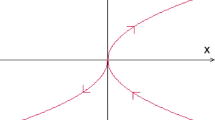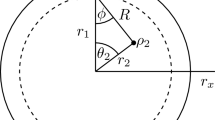Summary
The aim of this paper is to construct some observables which can distinguish, by means of measurements of correlation functions, whether a quantum system is described by a state vector of the I type (proper mixture) or by a state vector of the II type (improper mixture). We apply a, theorem proved in a previous paper to the «singlet» state of two spin-1/2 particles. The widest class of sensitive observables is constructed and shown to depend on four real parameters. A particular subclass is studied in detail: its sensitivity is such that one has to distinguish experimentally between 1 and 3 in the most meaningful case. An inverse application of our theorem to the Friedbeg-Jammer observable leads to the determination of the state for which this observable is sensitive. This state is a superposition of products of linear-polarization states of the two particles along orthogonal axes. Also in this case one has to distinguish experimentally between 1 and 3.
Riassunto
Lo scopo del lavoro è costruire alcune osservabili che possono distinguere, per mezzo di misure di funzioni di correlazione, se un sistema quantico è descritto da un vettore di stato del I tipo (miscela propria) o da un vettore di stato del II tipo (miscela impropria). Si applica un teorema dimostrato in un lavoro precendente allo stato di «singoletto» di due particelle di spin 1/2. Si costruisce la più ampia classe di osservabili sensibili e si mostra che questa dipende da quattro parametri reali. Si studia in dettaglio una particolare sottoclasse: la sua sensibilità è tale da dover distinguere fra 1 e 3 nel caso più significativo. Un’applicazione inversa del teorema all’osservabile di Friedberg-Jammer conduce alla determinazione dello stato per il quale quest’osservabile è sensibile. Questo stato è una sovrapposizione di prodotti di stati di polarizzazione lineari delle due particelle lungo assi ortogonali. Anche in questo caso si deve distinguere sperimentalmente fra 1 e 3.
Резюме
Цель этой статяи—сконструировать некоторые наблюдаемые, которые можно различить с помощью измерений корреляционных функций, в зависимости от того, описывается ли квантовая система вектором состояния первого тица (собственное смешивание) или вектором состояния второго тила (несобственное смешивание). Мы применяем теорему, доказанную в предыдущей статье к «синглетному» состоянию двух частиц со спином половина. Конструируется широкий класс чувствительных наблюдаемых и показывается, что они зависят от четырех вещественных параметров. Подробно исследуется специальный подкласс: чувствительность этого подкласса является такой, чтовозможно экспериментально различить 1 и 3 в случае, имеющем глубокий физический смысл. Обратное применение нашей теоремы к наблюдаемой Фридберга-Джаммера приводит к определению состояния, для которого эта наблюдаемая является чувствительной. Это состояния, для которого эта наблюдаемая является чуваствительной. это состояние представляет суперпозицию произведений линейных состояний поляризации системы двух частиц вдоль ортогональных осей. В этом случае также возможно экспериментально различить 1 и 3.
Similar content being viewed by others
References
N. Cufaro Petroni:Nuovo Cimento,40 B, 235 (1977).
J. S. Bell:Physics,1, 185 (1965).
V. Capasso, D. Fortunato andF. Selleri:Int. Journ. Theor. Phys.,7, 319 (1973).
D. Fortunato andF. Selleri:Int. Journ. Theor. Phys.,15, 333 (1976).
D. Fortunato, A. Garuccio andF. Selleri:Int. Journ. Theor. Phys., to be published.
D. Fortunato:Lett. Nuovo Cimento,15, 289 (1976).
R. Friedberg:Verifiable consequences of the Einstein-Podolsky-Rosen criterion for reality, unpublished (1969), inM. Jammer:The Philosophy of Quantum Mechanics (New York, N. Y., 1974), p. 246.
J. F. Clauser, R. S. Holt, M. A. Horne andA. Shymony:Phys. Rev. Lett.,23, 880 (1969).
J. J. Freedman andJ. F. Clauser:Phys. Rev. lett.,28, 938 (1972).
G. Faraci, D. Gutkowsky, S. Notarrigo andA. R. Pennisi:Lett. Nuovo Cimento,9, 607 (1974);M. Bruno, M. D’Agostino andC. Maroni: University of Bologna, preprint (1976).
R. A. Holt andF. M. Pipkin: Harvard University, preprint.
J. F. Clauser:Nuovo Cimento,33, 740 (1976).
Author information
Authors and Affiliations
Additional information
Переведено ребакцией.
Rights and permissions
About this article
Cite this article
Petroni, N.C. On the observable differences between proper and improper mixtures.—II. Nuovo Cim B 40, 381–397 (1977). https://doi.org/10.1007/BF02728221
Received:
Published:
Issue Date:
DOI: https://doi.org/10.1007/BF02728221




